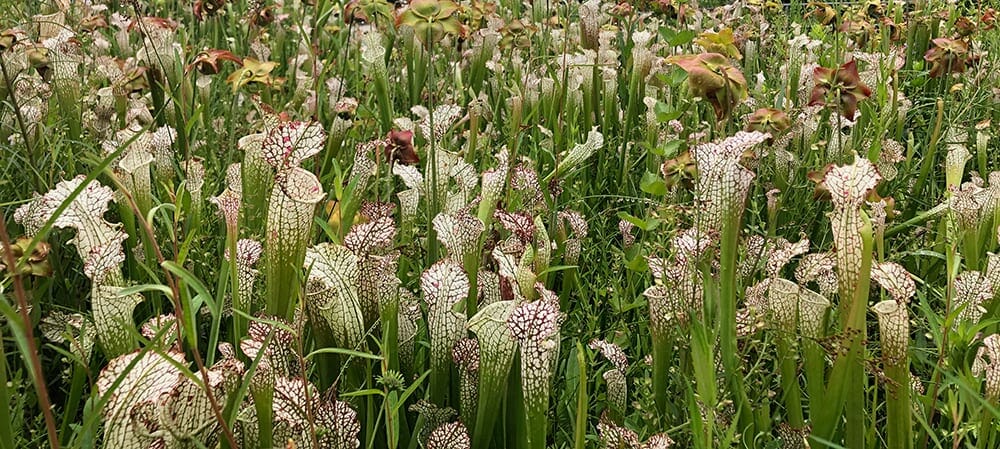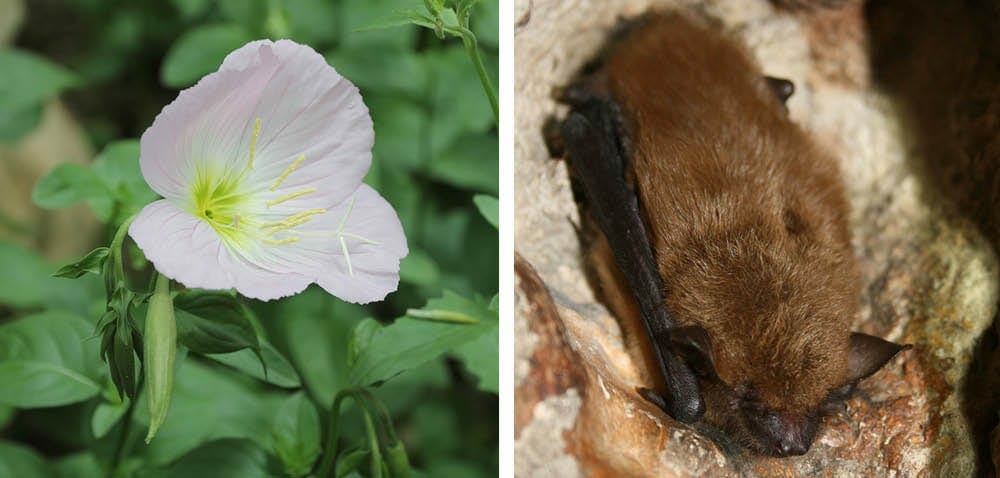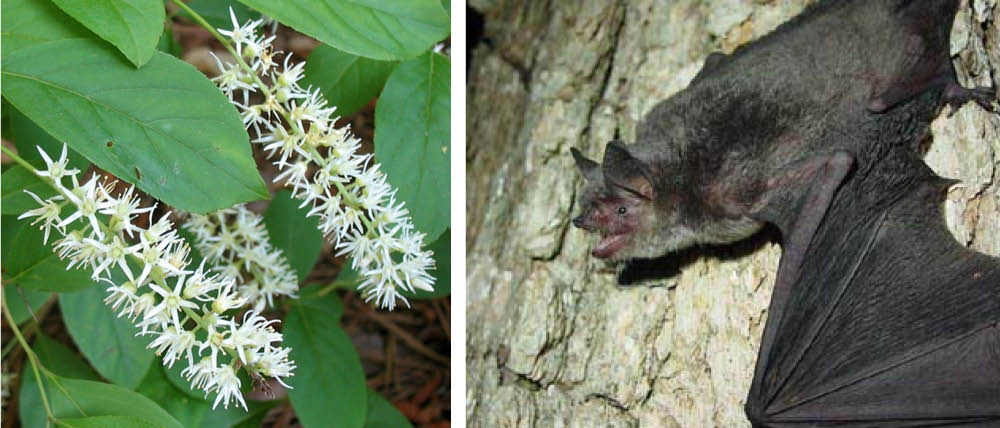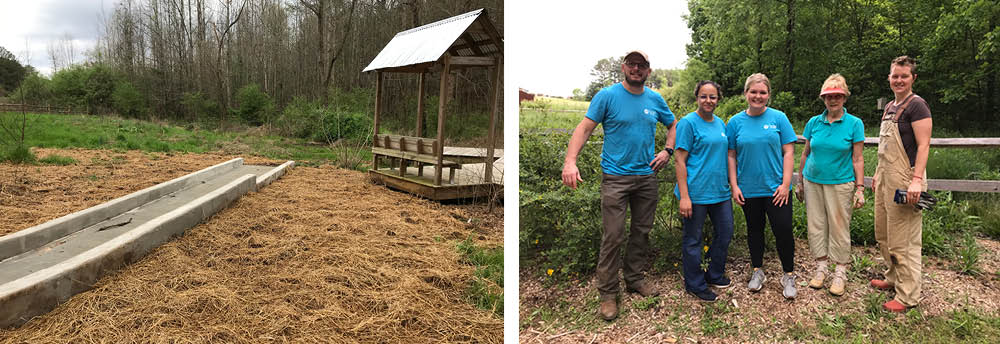
Now is a great time to visit the collection of pitcher plants (Sarracenia spp.) and other carnivorous plants at the Atlanta Botanical Garden.
Federal Grant Supports Native Plant Conservation
A partnership forged by the Georgia Plant Conservation Alliance has resulted in a federal grant of about $780,000 that focuses on the conservation of 14 imperiled plant species native to Georgia. The plants include
- Alabama leatherflower (Clematis socialis),
- black-spored quillwort (Isoetes melanospora),
- Canby’s dropwort (Oxypolis canbyi),
- Coosa (or Mohr’s) Barbara’s buttons (Marshallia mohrii),
- dwarf sumac (Rhus michauxii),
- fringed campion (Silene polypetala),
- hairy rattleweed (Baptisia arachnifera),
- mat-forming quillwort (Isoetes tegetiformans),
- Morefield’s leatherflower (Clematis morefieldii),
- pondberry (Lindera melissifolia),
- smooth purple coneflower (Echinacea laevigata),
- swamp pink (Helonias bullata),
- Tennessee yellow-eyed grass (Xyris tennesseensis), and
- Virginia spiraea (Spiraea virginiana).
All of the species are listed as endangered or threatened under the Endangered Species Act. You can learn more about the project and the efforts of the Department of Natural Resources, the State Botanical Garden of Georgia, the Atlanta Botanical Garden, and the Chattahoochee Nature Center at the DNR web site.
What’s the buzz on new chapters?
New chapters are moving full steam ahead and are meeting to finalize their formation documents and planning activities around the state. Most have chosen their names, using a traditional geographic name like North Metro Atlanta Chapter, North Georgia Mountains Chapter, Athens-East Piedmont Chapter, and Intown Atlanta Chapter, while the Macon area chapter has chosen The Fringed Campion Chapter.
If you are interested in being part of one of these chapters, make sure you have affiliated with the chapter on the Chapter Affiliation Form on the GNPS website so you can stay in the know on your chapter’s activities. If you have questions, email membership@gnps.org.
Plant Spotlight: Monarda didyma
Ellen Honeycutt
My seasonal choice for this month’s newsletter always reminds me of fireworks, which I think is appropriate for early July. Scarlet beebalm (Monarda didyma) or Oswego tea is a perennial native plant in the mint family (Lamiaceae) blooming now. In Georgia, the natural reported range is just four northern counties but this is a plant that is much loved by gardeners so it is probably growing in almost all the counties by now. I have seen it growing naturally at Lake Winfield Scott in Union County.
According to Linda Chafin’s Field Guide to the Wildflowers of Georgia, its habitat is “seepy areas and on stream banks in the Blue Ridge” area of the state. The individual tubular flowers are clustered in a terminal arrangement on the top of a square stem. As the early flowers fade, a ring of outer ones represents the last of them. In ideal conditions, stems can reach up to 6 feet. Of course, like most plants in the mint family, it will spread, so site it where spread can be tolerated or share extras with friends. When kept moist, cuttings can be rooted or use pieces of the roots.
The genus Monarda is named in honor of a 16th century Spanish physician and botanist, Nicolas Monardes (1493-1588). This particular species can be susceptible to powdery mildew; the cultivar ‘Jacob Cline’ is one selected for resistance to that with no detriment to pollinators. The flowers are attractive to hummingbirds and large butterflies as well as bees.

Pipevine swallowtail on Scarlet beebalm (Monarda didyma) and closeup of flower. Photos by Ellen Honeycutt.
Native Fauna Need Native Flora: Georgia Bats
Deborah Ashley
One of the things I am trying to do with this column is to make myself and others aware of how much the two ecosystems of fauna and flora are so interrelated. I have written so far about a native butterfly, bee, and bird. So naturally, I needed to investigate what Georgia mammals have a direct dependency on Georgia native plants. So, I picked Georgia bats! Then I realized that in explaining what Georgia native plants have to do with bats, I have to include another ecosystem. That ecosystem is insects.
We have 16 species of bats in Georgia. Three of these species are listed as endangered by both federal and Georgia agencies. These bats are the Indiana bat (Myotis sodalis), Northern long-eared bat (Myotis septentrionalis), and the gray bat (Myotis grisescens). Rafinesque's big-eared bat (Corynorhinus rafinesquii) is considered rare in Georgia. Five species are species of concern in Georgia, just one step away from being endangered. These are tri-colored bat [formerly Eastern pipistrelle] (Perimyotis subflavus), little brown bat (Myotis lucifugus), Eastern small-footed bat (Myotis leibii), Southeastern bat (Myotis austroriparius) and the Northern yellow bat (Lasiurus intermedius).That leaves only seven species that seem to be doing well in Georgia, but do need our help.
I know that there are many species of bats in the west and southwest of our country that drink nectar from plants for food, and by doing so pollinate these flowers. This is not the case in Georgia. We do not have nectar drinking bats. So, imagine my surprise when I learned from the Georgia DNR website that there was a link for native plants that attract bats. What could this mean?

Left: Pink lady evening primrose (Oenothera speciosa) and other light-colored flowers are more visible at night, attracting moths and, indirectly, bats. (Photo © C T Johansson cc-by-sa-3.0.) Right: A big brown bat at rest (photo by Ann Froschauer / U.S. Forest Service).
What it meant was that our native bats are insect eaters. To find the insects they need to survive, they depend on many of our native plants to attract them, so they can make a meal of them. And that’s great for humans, because a single bat can eat 6,000 to 8,000 mosquitos in one evening.
Georgia also has an amazing number of native plants that act as host plants to the moths that bats need to survive. I know we hate to set moths up to become food for bats, but we must preserve our native bats.
Moths are attracted to light colored flowers because it is believed they reflect the moon’s light and make them easy targets for all night flying insects. Pink lady evening primrose (Oenothera speciosa) and Common evening primrose (Oenothera biennis) are two that attract moths, and thus bats.
Examples of white or light-colored flowers to attract night insects include white wild indigo (Baptisia alba), goats-beard (Aruncus dioicus), shooting star (Dodecatheon meadia), white milkweed (Asclepias variegata), Indian hemp (Apocynum cannabium), Culver's root (Veronicastrum virginicum), foxglove beardtongue (Penstemon digitalis), white snakeroot (Ageratina altissima), virgin's-bower (Clematis virginiana), Virginia sweetspire (Itea virginica), elderberry (Sambucus canadensis), winterberry (Ilex verticillata), and flowering dogwood, (Cornus florida).

Left: Virginia sweetspire (Itea virginica) is one of many white-flowered plants that attract moths. Right: Endangered gray bat (Photo by Adam Mann, Environmental Solutions and Innovations / U.S. Forest Service).
A few examples of host plants for moths are persimmon (Diospyros virginiana), sweetgum (Liquidambar styraciflua), hickories (Carya spp.), walnuts (Juglans spp.), and sumacs (Rhus spp.). These are host plants to the female luna moth. She lays several hundred eggs on the underside of the leaves of these plants. Although the adults live only a short while, they are great food sources for our Georgia bats!
Examples of other host plants (and you’ll have to look up the moths yourself!) are spotted Joe Pye weed, (Eutrochium maculatum), wild geranium (Geranium maculatum), smooth ox eye (Heliopsis helianthoides), winterberry (Ilex verticillata), blazing star (Liatris spp.), and cardinal flower (Lobelia cardinalis).
If you would like to see a complete list of the native plants of Georgia that act as either host plants for moths and white flowers to attract night moths and insects to help our bats, you will find a great PDF at the Georgia DNR site.
You will be amazed, and the Georgia bats will thank you.
Chapter News: West Georgia
Elyse Wheeler
Members of the West Georgia Chapter have been busy this Spring despite the rain! We were fortunate to receive grant funding from both the Community Foundation of Carrollton and the Carrollton EMC. The funding supported significant improvement of the infrastructure of the Buffalo Creek Trail Outdoor Education Center. One structure originally constructed as a Boy Scout project had fallen into disrepair. The roof has been repaired, the foundations improved and the old siding removed to produce the newly designated Meadow Pavilion. The firepits in the meadow are now fire safe with crushed granite rings. Park benches have been installed and picnic tables are in the process of construction. The area is now ready for a summer picnic!

In the spirit of conservation, materials from the reconstruction of the Meadow Pavilion were repurposed to salvage an outbuilding that had also fallen into disrepair. Several wooden signs which highlighted all the organizations and individuals who contributed early in the restoration project and were no longer displayed were installed on the front of the new tool shed. It is lovely to once again acknowledge the generous support of the Carrollton community. The shed allows for the storage of tools which come in handy when we have volunteers who need gloves or hand tools to help along the trail.

Another activity supported by the grant funds will be the installation of trail signs throughout the BCT Outdoor Education Center. We are fortunate to have developed a partnership with Eric Young, the advisor for the Technology Club at Carrollton High School. His students wish to work on projects that have real world application and they will be fabricating the directional signs as well as informational signs to illustrate the variety of trees and plants along the trail. Work begins in the school year ‘21- ‘22. We are excited to have the young people working with us.
The Pollinator Garden is located just off the GreenBelt in Carrollton. Due to a drainage issue, heavy rains produced significant flooding in the garden. A new volunteer on the Board, John Denney worked with the city officials to create a solution to the problem. The new concrete alley handles the outpouring which runs under the GreenBelt. Plans are underway for landscaping the sides and to channel the water into the marshy area of the Pollinator Garden for water-loving plants.

Despite the heavy rains, the day of the Spring Native Plant Sale was a success in more ways than one! Beginning at 7 am while the vendors were setting up through noon, the heavens poured down. But over one hundred valiant souls braved the rain to attend. Plants were offered for sale by the West Georgia Chapter members along with local vendors of native plants (Little Creek Farm Nursery, Hiram; Flat Creek Natives, Perry; and Cottage Garden Natives, Lithonia). Sales were brisk. Even better, a significant number of the attendees indicated this was their first exposure to native plants, they were highly interested in learning more about native plants and they were likely to become members of the GNPS. It was a great, if soggy, day all the way around.
Speaking of enthusiasm, in between the rains, we were fortunate to have volunteers from both Carroll County EMC and Miller Zell, Inc. Their enthusiastic assistance is greatly appreciated.
In the city of Carrollton, two additional projects are underway. Diane Rooks is rescuing the gardens outside the Barker House, the used book house supported by Friends of Neva Lomason Memorial Library. After a large tree was removed, the English ivy took over. Diane is clearing the ivy and planting native plants volunteered from her own garden.
The second project is located at the Carrollton Center for the Arts. The Center installed a peace pole with a bench for moments of reflection. WGC was asked to construct a garden of native plants to highlight the area. Plants including Stokes aster and Echinacea were donated from Carol Hight’s garden. A week of extraordinary hot weather challenged the plants but the blooms are coming along.
We would also like to give a shout out to Robert Barr who is a Carnivorous Plant enthusiast. The Southeastern Carnivorous Plant Society is holding a Meet (open to the public), Sunday August 1st beginning at 1PM. They will meet in Gold Dust Park at the Pavilion in Villa Rica.
We have enjoyed the spring and are excited to begin our meetings again in August.
|